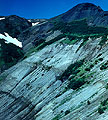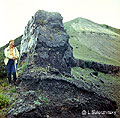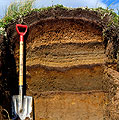1000-05
Stübel Cone: 51°49' N, 157°32' E
Ksudach volcanic massif is located in the frontal volcanic zone of Kamchatka. It is noted for repetitive voluminous caldera-forming eruptions during Late Pleistocene-Holocene and large explosive eruptions from the Shtyubel' (Stübel) volcano, located within the most recent caldera. The only historically recorded eruption occurred in 1907; its fall deposit can be traced to the north for more than 200 km.

Ksudach volcanic massif is a shield-like polygenetic edifice composed of lavas and tephra of multiple eruptive centers of various age and morphology. It comprises nested calderas which formed during five collapse events. Two larger calderas (I and II) formed in the Late Pleistocene time and three smaller ones (III, IV and V) during the Holocene. Caldera V encloses an active stratovolcano named Shtyubel' (Stübel) Cone (Figs.1,2); its most recent eruption occurred in 1907. The pyroclastic deposits of the largest Holocene eruptions are tens to hundreds of meters thick near the vent (Fig. 3) and form layers which can be traced over much of the Kamchatka Peninsula and thus, are wonderful markers for the Holocene stratigraphy.
Holocene eruptive products are low-K2O two-pyroxene-plagioclase basaltic andesite to rhyodacite. Tephras from the caldera-forming eruptions are andesite to rhyodacite with volumes ranging from 1.5 to 19 km3. Shtyubel' Cone erupted basaltic andesite to rhyodacite, with eruption volumes of up to 2 km3. Most of Ksudach tephras contain both silicic and mafic pumice in the same units, and abundant taxitic pumice varieties with alternating silicic and mafic bands, that suggests the intensive mixing of the melts in the course of the Ksudach eruptions (Volynets, 1979).
Holocene activity of Ksudach started about 8800 years BP, when caldera III was formed as a result of the KS4 eruption. The deposits of the KS4 eruption include several tephra fall units, alternating with pyroclastic surge beds and explosion breccia, capped with a pyroclastic flow unit. Total volume of juvenile tephra is estimated at 1.5-2 km3 (about 0.8 km3 DRE - dense rock equivalent). Initial fall unit contains the most silicic (rhyodacitic) pumice bombs while later products are dominantly andesites and dacites. Near the vent black andesitic bombs are occasionally welded (Selyangin, 1990).
Next caldera IV formed about 6000 years BP as a result of two closely spaced in time large eruptions KS3 and KS2. Both large eruptions (KS3 and KS2) produced explosion breccias, pyroclastic flows and falls. KS3 juvenile deposits contain mainly white rhyodacitic and yellowish dacitic pumice with only a minor admixture of black andesitic lapilli. KS2 fall deposits are represented by a thick unit of gray, dark-gray and violet finely banded pumice bombs which are occasionally welded (Fig.4). The bulk composition of KS2 tephra was uniformly andesitic throughout the eruption. Eucrite and allivalite xenoliths are abundant (Volynets et al., 1978). Total volume of tephra of both large eruptions (KS2 and KS3) is estimated at about 10-11 km3 (or 4.7 km3 DRE) most of which (70-80%) is presented by KS2 eruption products. The formation of caldera IV was followed by the growth of a series of dacitic extrusive domes with a total volume of about 0.5 km3 (see map).
The youngest caldera-forming (caldera V) eruption KS1, took place about AD 240. The KS1 eruption was the second largest Holocene eruption in Kamchatka, after the Kurile Lake caldera, and was similar in type and characteristics to the 1883 Krakatau eruption. The KS1 eruption produced about 18-19 km3 (8 km3 DRE) of tephra. The estimated height of eruptive column is 22-30 km. A collapse caldera resulting from this eruption was 4 x 6.5 km in size with a cavity volume of 6.5-7 km3. Pyroclastic flows accompanied by ash-cloud pyroclastic surges extended out to 20 km. Tephra-fall was deposited to the north of the volcano at a distance of more than 1000 km and is one of the most important marker horizons for the Holocene deposits (Figs.5-7).
Proximal tephra-fall deposits are pumice lapilli and bombs. At least four bomb beds are identified, each underlying pyroclastic-flow deposits. Pumices of the lower three beds are white or yellow and those of the upper bed are blue-gray. Both white and gray pumice bombs and lapilli are rhyodacites. The KS1 tephra retains its two-color structure downwind along its main dispersal axis (Fig.5).
Within eastern Kamchatka, to the east of the main dispersal axis, the KS1 tephra is a yellow, coarse to fine ash (Fig.6). In the Kamchatka river valley, along the dispersal axis, the tephra comprises two layers: yellow coarse or fine ash below and grey fine ash at the top (Fig. 7). These two layers correspond to two packets of pyroclastics at Ksudach volcano: a lower white or yellow packet and an upper gray one. Within Sredinny Range, to the west of the main axis, the KS1 tephra is presented only by gray ash, which was not found within eastern Kamchatka. This pattern is interpreted to result from a shift of ash dispersal axes for "yellow" and "gray" tephra.
The voluminous KS1 eruption was probably an ecological catastrophe for Kamchatka, due to dispersal of tephra mainly along the peninsula. The minimum area of total devastation coinciding with pyroclastic-flow deposits and heavy tephra fallout (following the 40-cm isopach) is about 400-500 km2. Vegetation was also adversely affected over an additional area of about 12 000 km2 where ash thickness was 5-40 cm.
Shtyubel' Cone began to grow within caldera V about a hundred years after caldera collapse. All subsequent eruptions from Ksudach, including the historically recorded one in 1907 (KSht3), originated from Shtyubel' Cone and were separated by quiescence periods less than a few hundred years. The formation of Shtyubel' Cone began from moderate explosive eruptions and extrusion of lavas. Later it gave three large explosive eruptions (KSht1, KSht2, KSht3 ) with eruption volumes up to 2 km3. The products of Shtyubel' Cone range from basaltic andesites to dacite and rhyodacite.
Fall deposits of the larger eruptions from Shtyubel' Cone (KSht1, KSht2, KSht3) are heterogeneous and consist of at least two subunits. The lower subunit is composed of black scoria bombs and lapilli of basaltic andesite whereas the upper subunit comprises white, pink and yellow dacitic to rhyolitic pumice bombs sometimes with an admixture of more mafic ones. Pumiceous subunits of these eruptions are rich in eucrite and allivalite xenoliths (Volynets et al., 1978; Selyangin, 1990).
Literature
Braitseva OA, Melekestsev IV, Ponomareva VV, Sulerzhitsky LD (1995) The ages of calderas, large explosive craters and active volcanoes in the Kuril-Kamchatka region, Russia. Bull Volcanol 57/6: 383-402
Braitseva OA, Melekestsev IV, Ponomareva VV, Kirianov VYu (1996) The caldera-forming eruption of Ksudach volcano about cal. AD 240, the greatest explosive event of our era in Kamchatka. Journ Volcanol Geotherm Research 70/1-2: 49-66
Braitseva OA, Sulerzhitsky LD, Ponomareva VV, Melekestsev IV (1997) Geochronology of the greatest Holocene explosive eruptions in Kamchatka and their imprint on the Greenland glacier shield. Transactions (Doklady) of the Russian Academy of Sciences. Earth science section. 352/1: 138-140
Braitseva OA, Ponomareva VV, Sulerzhitsky LD, Melekestsev IV, Bailey J (1997) Holocene key-marker tephra layers in Kamchatka, Russia. Quaternary Research, 47: 125-139
Bursik MI, Melekestsev IV, Braitseva OA (1993) Most recent fall deposits of Ksudach volcano, Kamchatka, Russia. Geophysical Research Letters, 20/17: 1815-1818
Hulten E (1924) Eruption of a Kamchatka volcano in 1907 and its atmospheric consequences. Geol. Foren. Forhandl. 46, 407-417
Macias JL, Sheridan MF (1995) Products of the 1907 eruption of Shtyubel’ Volcano, Ksudach Caldera, Kamchatka, Russia. GSA Bulletin, 107/8, 969-986
Melekestsev IV, Braitseva OA, Ponomareva VV, Sulerzhitsky LD (1996) Holocene catastrophic caldera-forming eruptions of Ksudach volcano, Kamchatka. Volcanology and Seismology, 17, 395-421
Selyangin OB (1990) Geologic structure and evolution of the calderas of Ksudach volcano. Volcanology and Seismology, 9/5: 690-713
Selyangin OB (1991) Ksudach volcano. In: Fedotov SA, Masurenkov YuP (Eds.) Active volcanoes of Kamchatka. Nauka Publishers. Moscow. P. 337-353 (In Russian and English)
Volynets ON, Ponomareva VV, Braitseva OA, Melekestsev IV, Chen.ChH (1999) Holocene eruptive history of Ksudach volcanic massif, South Kamchatka: evolution of a large magmatic chamber. Journal of Vocanology and Geothermal Research 91: 23-42






